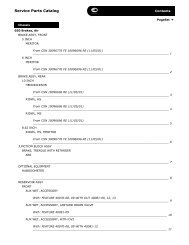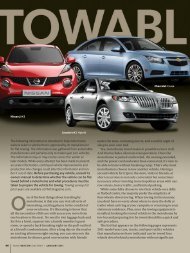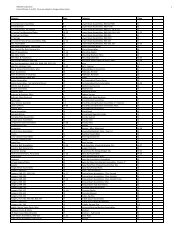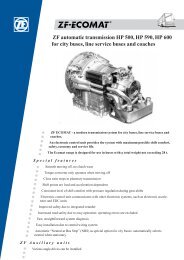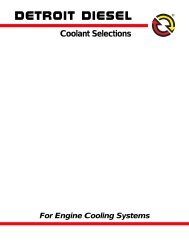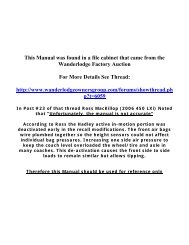Michelin Truck Tire Data Book - Wanderlodge Owners Group
Michelin Truck Tire Data Book - Wanderlodge Owners Group
Michelin Truck Tire Data Book - Wanderlodge Owners Group
- No tags were found...
Create successful ePaper yourself
Turn your PDF publications into a flip-book with our unique Google optimized e-Paper software.
PROPER APPLICATION OF ON/OFF ROAD (Y AND L) TIRES*The tires with “Y” or “L” (see Page 25) as the thirdcharacter in the tread designations are designed and optimizedfor on/off road applications and are speed restricted.These tires should not be used in applications thatoperate the tires continuously on highway over an extendedperiod of time or at speeds that exceed the speed ratingof the tire. This could lead to heat build up and cause prematureor sudden tire failure.<strong>Tire</strong>s with the “Y” designation are for applicationsexpected to be 80% On-road use and 20% Off-road use.They have a maximum speed of 65 mph.<strong>Tire</strong>s with the “L” designation are for applicationsexpected to be 20% On-road use and 80% Off-road use.Some of the “L” designated tires have a maximum speedof 50 mph while others have maximum speeds of 55, 60and of 70 mph.<strong>Tire</strong>s optimized for highway applications have a maximumspeed of 75 mph.The <strong>Tire</strong> and Rim Association (TRA) permits operatinga 65 mph rated tire at higher speeds with a reducedload and increased inflation. No such permission isgranted by TRA for tires with speed rating rated below65 mph.Always refer to this <strong>Michelin</strong> <strong>Truck</strong> <strong>Tire</strong> <strong>Data</strong> <strong>Book</strong>on Page 25 and match the tire to the application whenmaking tire selections.(*) Exceeding the safe, legal speed limit is neither recommended nor endorsed.COLD CLIMATE PRESSURE CORRECTIONBecause the air pressure inside a tire will decrease whenthe vehicle is taken from a warm environment to a coldone, some adjustments may be necessary when adjustingthe tire pressures of a vehicle to be operated in very coldtemperatures.These adjustments are only necessary if the pressures areverified and adjusted inside a heated garage with an airsupply that is also at the higher room temperature. (Noadjustment necessary if done outside.)In extreme cases, the following table should be used tohelp ensure that the operating pressure and deflection oftires are adequate at the outside ambient temperature.Using the load and pressure charts in the book, determinethe appropriate “Recommended Pressure” required forthe axle load. Then find the same pressure down the leftcolumn of the table to the right. Going across to the relevantoutside ambient temperature you will find the correctedinflation pressure to be used.For example:A log truck in Alaska has a frontaxle capacity of 12,000 lbs.The truck is equipped with11R24.5 XZY ® 3 LRG tires.The recommended pressure forthis fitment is 105 psi.The truck is parked overnightin a heated garage.The outside high forecasted fortoday is -20 o F.The tire pressures are checkedand adjusted prior to leavingthe heated garage.According to the the chartbelow, the tires should beadjusted to: 128 psi.RecommendedPressure(psi)*°F°CAdjusted Inflation Pressure (PSI)(when inflating indoors at 65°F [18°C])Outside Ambient Temperature50° 40° 30° 20° 10° 0° -10° -20° -30° -40° -50°10° 4° -1° -7° -12° -18° -23° -29° -34° -40° -46°75 78 80 81 83 86 88 90 92 95 98 10080 83 85 87 89 91 93 96 98 101 104 10785 88 90 92 94 97 99 102 104 107 110 11390 93 95 98 100 102 105 108 110 113 116 11995 98 101 103 105 108 111 113 116 119 123 126100 103 106 108 111 113 116 119 122 125 129 132105 109 111 114 116 119 122 125 128 132 135 139110 114 116 119 122 125 128 131 134 138 141 145115 119 122 124 127 130 133 137 140 144 148 151120 124 127 130 133 136 139 143 146 150 154 158125 129 132 135 138 141 145 148 152 156 160 164130 134 137 140 144 147 150 154 158 162 166 171* Never exceed the rim manufacturer’s maximum air pressure limitation.Appendix85



